 Many people ask me why I am so obsessed with wine. How can I spend so much time researching it, talking about it, dreaming about it? Well, everything that drives us in our lives is usually connected to some unresolved childhood issue. When I was growing up, I had problems connecting with people… even on the most basic level. I didn’t know how to have a conversation… or even how to approach someone. This was due to my having a dysfunctional home – biological parents who really didn’t want kids and were detached -they couldn’t even have a simple relationship with a friend, let alone a parent-child relationship. And so I spent a lot of time alone, reading books, dreaming of having a family, being part of a community, connecting with people around the world. Through many years of working on myself and getting involved in the highly social world of wine, I have connected with more people around the globe than I could have imagined.
Many people ask me why I am so obsessed with wine. How can I spend so much time researching it, talking about it, dreaming about it? Well, everything that drives us in our lives is usually connected to some unresolved childhood issue. When I was growing up, I had problems connecting with people… even on the most basic level. I didn’t know how to have a conversation… or even how to approach someone. This was due to my having a dysfunctional home – biological parents who really didn’t want kids and were detached -they couldn’t even have a simple relationship with a friend, let alone a parent-child relationship. And so I spent a lot of time alone, reading books, dreaming of having a family, being part of a community, connecting with people around the world. Through many years of working on myself and getting involved in the highly social world of wine, I have connected with more people around the globe than I could have imagined.
In my opinion, wine, more than any other product, is intertwined with the various facets of issues that greatly affect the human condition. I highly recommend the book, Hungry for Wine as an ideal example of a collection of wine stories that touch on economy, equality, sociology and most of all how this special libation helps to stir conversations that touch our innermost desires. I’m still not good at small talk, but with wine that never seems to be an issue… many times, whether it is with a friend or colleague or winemaker, our conversations always run towards deeper, more substantial topics. No one gets into the wine business to make money… there are not only other businesses that are more lucrative, but there are other alcoholic drinks that bring in a better profit. But many are still drawn to wine… maybe because of its ties to family, history, culture and how this drink forces us to take the time to get to know the heart of someone beyond their superficial shell.
Emilio Moro Bodegas
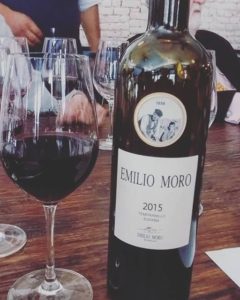 And so goes a lunch spent with José Moro, winemaker and president of his family winery Emilio Moro Bodegas, tasting his wines, infused with an exchange of thoughts of how to make the world a better place.
And so goes a lunch spent with José Moro, winemaker and president of his family winery Emilio Moro Bodegas, tasting his wines, infused with an exchange of thoughts of how to make the world a better place.
Let me just touch upon some important points about the Ribera del Duero region in Spain, and specifically the initiatives in the vineyards and winery employed by Emilio Moro Bodegas, before I go into my conversation with José about social responsibility.
Ribera del Duero
Ribera del Duero started to get international acclaim in the 1980s for producing Spanish reds with great concentration and structure, that were built to be long-lived wines. Their main grape variety, Tinto Fino, a local variant (or some may call clone or biotype) of Rioja’s Tempranillo. Tinto Fino has smaller grapes with looser bunches, hence why it produces wines with extraordinary depth and intensity. Ribera del Duero is the DO (demarcated area) in Spain with the highest average altitude, between 750 and 1,000 meters (2460-3280 feet) above sea level. This creates extremes in the climate with long, harsh winters and hot, dry summers, and plenty of rainfall during the spring. These are just a few factors why this area of Spain has been heralded as producing some of the greatest red wines in the world.
Emilio Moro started with José’s grandfather, Emilio, and is named after this patriarch that not only started the family’s wine business, but also laid down the pillars which would serve to inspire future generations: tradition, innovation and social responsibility.
 José remembers learning these lessons very early as a young child looking up to his father, also named Emilio like his grandfather, and going to work at an early age. He remembers climbing into the small opening of the big casks with a brush and candle to clean the inside of these barrels. Of course, he said that you would not do that to a child nowadays but back then, adults had the attitude that those experiences that didn’t kill their children just made them stronger; similarly, how many of us remember ourselves as children, in a public playground swinging on metal monkey bars and cutting ourselves on rusty nails that were sticking out… how times have changed.
José remembers learning these lessons very early as a young child looking up to his father, also named Emilio like his grandfather, and going to work at an early age. He remembers climbing into the small opening of the big casks with a brush and candle to clean the inside of these barrels. Of course, he said that you would not do that to a child nowadays but back then, adults had the attitude that those experiences that didn’t kill their children just made them stronger; similarly, how many of us remember ourselves as children, in a public playground swinging on metal monkey bars and cutting ourselves on rusty nails that were sticking out… how times have changed.
Wine Saves Water
José has a huge feeling of gratitude for his family’s previous struggles and the legacy they have built that he has inherited with his brother and sisters. He continued to innovate by building a state-of-the-art winery called Cepa 21, as well as with working with Universities to isolate the Tinto Fino clone and the best indigenous yeasts to ferment it. But the project that he seemed the most proud of was his Wine Saves Water foundation.
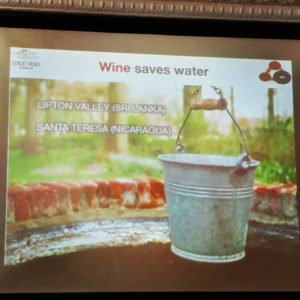 José was greatly distressed to see data that showed that while 71% of the earth surface is water, only 3% is fresh water and only a 0.5% is fit for human consumption. He has worked with communities in Spain, as well as other countries such as Sri Lanka and Nicaragua, to implement programs to make potable water available to impoverished people. If you have ever suffered from extreme dehydration, or even have had a pet that didn’t drink enough water, you have probably realized that we can live a while without food but getting enough water on a regular basis is key to health and survival.
José was greatly distressed to see data that showed that while 71% of the earth surface is water, only 3% is fresh water and only a 0.5% is fit for human consumption. He has worked with communities in Spain, as well as other countries such as Sri Lanka and Nicaragua, to implement programs to make potable water available to impoverished people. If you have ever suffered from extreme dehydration, or even have had a pet that didn’t drink enough water, you have probably realized that we can live a while without food but getting enough water on a regular basis is key to health and survival.
These programs have extended to offering meals, as well as training to disadvantaged children to learn valuable skills so they will have better opportunities for more meaningful employment with wineries and restaurants.
Wine’s Relationship to Social Responsibility
I’m not saying that all wine producers hold social responsibility as a high priority. If you were to Google this topic, I’m sure you would read a lot of horror stories of workers being mistreated and marginalized, especially in the vineyards. But don’t be dishearten by such stories, as there are plenty of families and producers like Emilio Moro. And to me, that is the whole reason why the world of wine is so special – because you can’t be truly a part of the world of wine unless you like people, all kinds of people, and you are willing to fight for them when they need you the most… that is the true dream of owning a winery… it’s not just the glamour of having a fantastic looking property and getting high scores for your wines, it is the fact that you are shaping the world to find a better sense of community over a lovely glass of wine.
***************************************************
Emilio Moro Wines Tasted on April 13th, 2017
There is braille lettering on all of the Emilio Moro labels. All of the Emilio Moro Bodegas wines were fermented with yeasts selected from their own vineyard.
 –2016 Cepa 21, Hito Rosado: 100% Tempraillo grapes from young vineyards at altitudes ranging from 750 to 800 meters (2460-2625 feet). A lovely, aromatic rosé with floral notes and wild, tiny strawberry flavors with a zesty citrus finish.
–2016 Cepa 21, Hito Rosado: 100% Tempraillo grapes from young vineyards at altitudes ranging from 750 to 800 meters (2460-2625 feet). A lovely, aromatic rosé with floral notes and wild, tiny strawberry flavors with a zesty citrus finish.
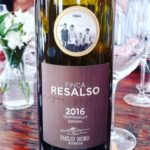 -2016 Emilio Moro Bodegas, Finca Resalso: 100% Tinto Fino sourced from their younger vines, as their range is set according to vine age. Silky texture and fresh acidity make this a pleasure to drink without food or with lighter dishes. Bright blackberry and spice with a touch of dusty earthy notes giving old world charm.
-2016 Emilio Moro Bodegas, Finca Resalso: 100% Tinto Fino sourced from their younger vines, as their range is set according to vine age. Silky texture and fresh acidity make this a pleasure to drink without food or with lighter dishes. Bright blackberry and spice with a touch of dusty earthy notes giving old world charm.
 -2015 Emilio Moro Bodegas, Emilio Moro: 100% Tinto Fino from vineyards ranging between 12 and 25 years old. 2015 was the hottest and driest vintage Ribera del Duero has seen in decades, but it is a testament to the care that Emilio Moro takes in their vineyards that this wine shows no notes of desiccated fruit. A rich, fruit forward wine with flavors of creme de cassis, lush texture with lots of round tannins. Simply delicious.
-2015 Emilio Moro Bodegas, Emilio Moro: 100% Tinto Fino from vineyards ranging between 12 and 25 years old. 2015 was the hottest and driest vintage Ribera del Duero has seen in decades, but it is a testament to the care that Emilio Moro takes in their vineyards that this wine shows no notes of desiccated fruit. A rich, fruit forward wine with flavors of creme de cassis, lush texture with lots of round tannins. Simply delicious.
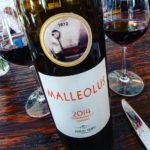 –2014 Emilo Moro Bodegas, Malleolus: 100% Tinto Fino from vineyards ranging between 25 and 75 years years old. The 2014 vintage had a combination of power and freshness that was displayed nicely in this Malleolus. The word “Malleolus” comes from the Latin word “majuelo” (small vineyard) and it refers to the vineyards in Pesquera de Duero. Still has the generosity that one expects from Emilio Moro yet it has a lightness to it with fresh leather and hints of balsamic vinegar and exotic spice all wrapped up in a firm structure.
–2014 Emilo Moro Bodegas, Malleolus: 100% Tinto Fino from vineyards ranging between 25 and 75 years years old. The 2014 vintage had a combination of power and freshness that was displayed nicely in this Malleolus. The word “Malleolus” comes from the Latin word “majuelo” (small vineyard) and it refers to the vineyards in Pesquera de Duero. Still has the generosity that one expects from Emilio Moro yet it has a lightness to it with fresh leather and hints of balsamic vinegar and exotic spice all wrapped up in a firm structure.
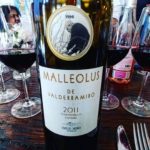 –2011 Emilo Moro Bodegas, Malleolus de Valderramiro: 100% Tinto Fino. The Malleolus de Valderramiro comes from a single vineyard, 10 acre (4 hectare) plot in Pesquera de Duero, planted in 1924. An aristocratic, opulent wine that is like a King or Queen who gives his/her whole heart and soul to their people. Dark chocolate covered cherries, orange peel and garrigue with chewy tannins, with hints of sweet tobacco. A wine that envelopes the palate with richness yet has a solid structure to give it a lot of backbone. A long, flavorful finish and pairs amazingly with grass fed rib eye. Only 7,000 bottles made.
–2011 Emilo Moro Bodegas, Malleolus de Valderramiro: 100% Tinto Fino. The Malleolus de Valderramiro comes from a single vineyard, 10 acre (4 hectare) plot in Pesquera de Duero, planted in 1924. An aristocratic, opulent wine that is like a King or Queen who gives his/her whole heart and soul to their people. Dark chocolate covered cherries, orange peel and garrigue with chewy tannins, with hints of sweet tobacco. A wine that envelopes the palate with richness yet has a solid structure to give it a lot of backbone. A long, flavorful finish and pairs amazingly with grass fed rib eye. Only 7,000 bottles made.
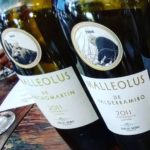 –2011 Emilio Moro Bodegas, Malleolus de Sanchomartin: 100% Tint Fino. The Malleolus de Valderramiro comes from a single vineyard, 2.1 acre (0.84 hectare) plot located in Pesquera de Duero. The vines were planted in 1964 by using cuttings from the oldest family vineyards. This wine slowly reveals itself through time with chalky minerality, brambly fruit and cardamom notes that playful dance about and never fully settles on the palate. A completely different experience of power and elegance than the Valderramiro, and so, shows the real difference of terroir with each vineyard. While the Valderramiro gives one everything all at once with a firm grip this Sanchomartin holds back and releases a little more with each sip as one contemplates on the finish. Only 2,500 bottles made.
–2011 Emilio Moro Bodegas, Malleolus de Sanchomartin: 100% Tint Fino. The Malleolus de Valderramiro comes from a single vineyard, 2.1 acre (0.84 hectare) plot located in Pesquera de Duero. The vines were planted in 1964 by using cuttings from the oldest family vineyards. This wine slowly reveals itself through time with chalky minerality, brambly fruit and cardamom notes that playful dance about and never fully settles on the palate. A completely different experience of power and elegance than the Valderramiro, and so, shows the real difference of terroir with each vineyard. While the Valderramiro gives one everything all at once with a firm grip this Sanchomartin holds back and releases a little more with each sip as one contemplates on the finish. Only 2,500 bottles made.










